-
Happy Birthday ICMag! Been 20 years since Gypsy Nirvana created the forum! We are celebrating with a 4/20 Giveaway and by launching a new Patreon tier called "420club". You can read more here.
-
Important notice: ICMag's T.O.U. has been updated. Please review it here. For your convenience, it is also available in the main forum menu, under 'Quick Links"!
You are using an out of date browser. It may not display this or other websites correctly.
You should upgrade or use an alternative browser.
You should upgrade or use an alternative browser.
First try and recycling
- Thread starter pinecone
- Start date
Your plants look great, Pine. I like your attitude on bugs too.
I took down a grow last week and noticed, wood bugs, one centipede, a few red wiggler worms, several types of spiders, soil mites and during the grow I caught a couple dozen fungus gnats in sticky traps. I brought in fresh outdoor compost during the grow and i mulch with old fan leaves and cut up stems.
I sprayed with neem once a week untill about two weeks in, but was pleased to see the bug diversity.......scrappy
I took down a grow last week and noticed, wood bugs, one centipede, a few red wiggler worms, several types of spiders, soil mites and during the grow I caught a couple dozen fungus gnats in sticky traps. I brought in fresh outdoor compost during the grow and i mulch with old fan leaves and cut up stems.
I sprayed with neem once a week untill about two weeks in, but was pleased to see the bug diversity.......scrappy
I took down a grow last week and noticed, wood bugs, one centipede, a few red wiggler worms, several types of spiders, soil mites and during the grow I caught a couple dozen fungus gnats in sticky traps. I brought in fresh outdoor compost during the grow and i mulch with old fan leaves and cut up stems.
Funny. After I got my first case of fungus gnats (years ago), I didn't feel great about my grown. I felt like I had made some sort of mistake by allowing them to come in somehow. Ditto for my first dealings with spider mites. How the fuck are these bugs getting in? - I thought.
Fast forward some years and I'm still amazed that all this stuff can make its way into a small indoor grow with filtered intakes and survive. The worms are probably the thing that trips me out the most. I was monitoring my mulch this past weekend and I found 2 small wigglers. I wouldn't be surprised if I have a breeding population. My best guess is that they came in a bag of store bought compost - vermicompost.
Pine
In my grow box I mounted transmission funnels on the walls. To these I added plastic tubing that goes to a T, then circles the plants for a lazy man's watering ring. It's just easier on my back. The funnels have kitchen sink screens to catch large chunks of whatever. In this last grow I started shorties in 7 gallon pots, and added mulch and compost as they grew. This buried the watering tubes eventually and they started draining slow. When I took down the grow I found 3/4 tubes were plugged. With worms! And worm debris and some roots. I don't add worms, but I suspect there were cocoons in the ewc. It's not all that important, but I thought it was interesting.......scrappy
My plants are about 5.5 weeks in on a strain that is suppose to finish at 8 weeks. Over the course of the last week I applied an ACT and about 8 teaspoons of a guano-kelp-castings mixture (just sprinkled around).
Overall the plants look pretty good. I am still having some problems with some of the cuttings. Right now I only have one plant, taken as a cutting from my #4 plant, which is capable of producing new cuts. For this reason, and because #4 is a fat, frosty, little fucker I think I'll run it again SOG style with 1.5-2' plants with an eye toward maximum yield. Right now I'm thinking about 6, 8 or 12 plants. Six would mean 2 rows deep and 2 across, 4 would mean 2 rows deep and 4 across, and 12 would mean 3 rows deep and 4 across.
Speaking of the cutting. I've been using Rapid Rooter plugs for rooting. The problem with these things is that they dry out over time. I've been trying to rehydrate them, but once they dry out they remain sort of crunchy. While I've rooted many a plant with crunchy plugs, they may have contributed to the problems I had rooting cuts from these plants. For this reason I'm going to try NAPA 8822 next.
I finally got around to harvesting some of the SSH bud that I intentionally pollinated. I guess I wasn't careful enough with the pollen because the entire crop was seeded. The branches I rubbed the male plant on were heavily seeded. From the #2 SSH plant I got more than half a film canister full of seeds. I made BHO with the trim from this seeded bud.
Pine
#1 and #2 front: #2 is a really nice looking plant, but I'm not going to be able to get cuts from her going until the end of the month, so I won't run her next (maybe after the next grow though).
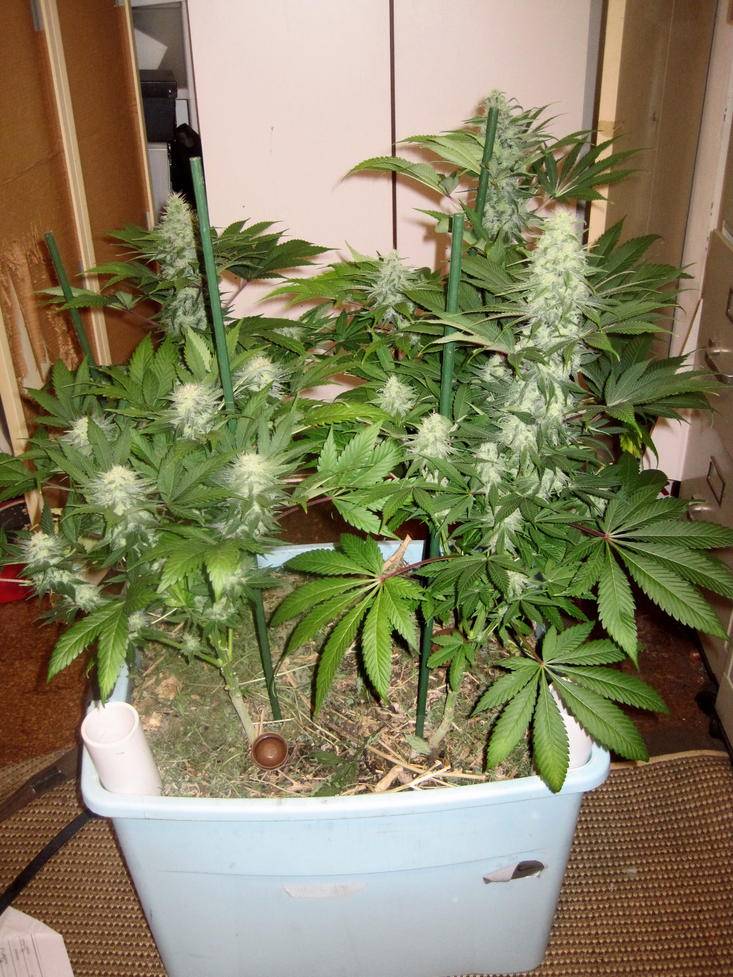
#2 bud shot:
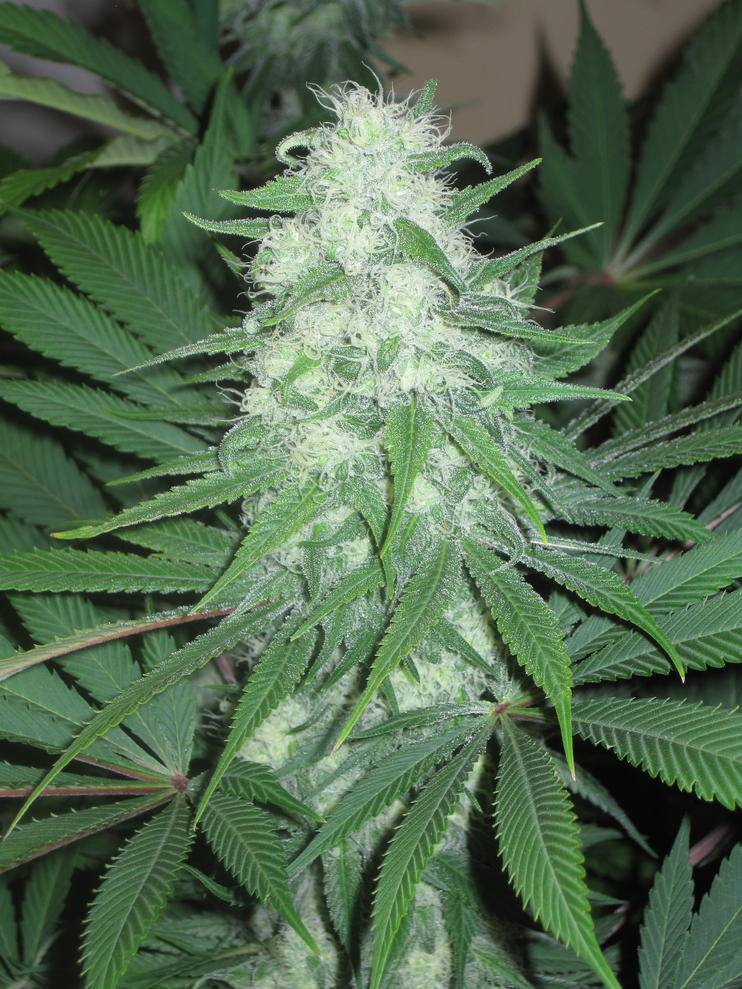
#3 and #4 front: #4 (right front) is the plant I plan to run next. #3 looks a bit pale in spots. I'm wondering if it isn't light bleaching because the paleness is uneven with the paler leafs being closer to the lamp. This is the tallest plant so it is closest to the light.
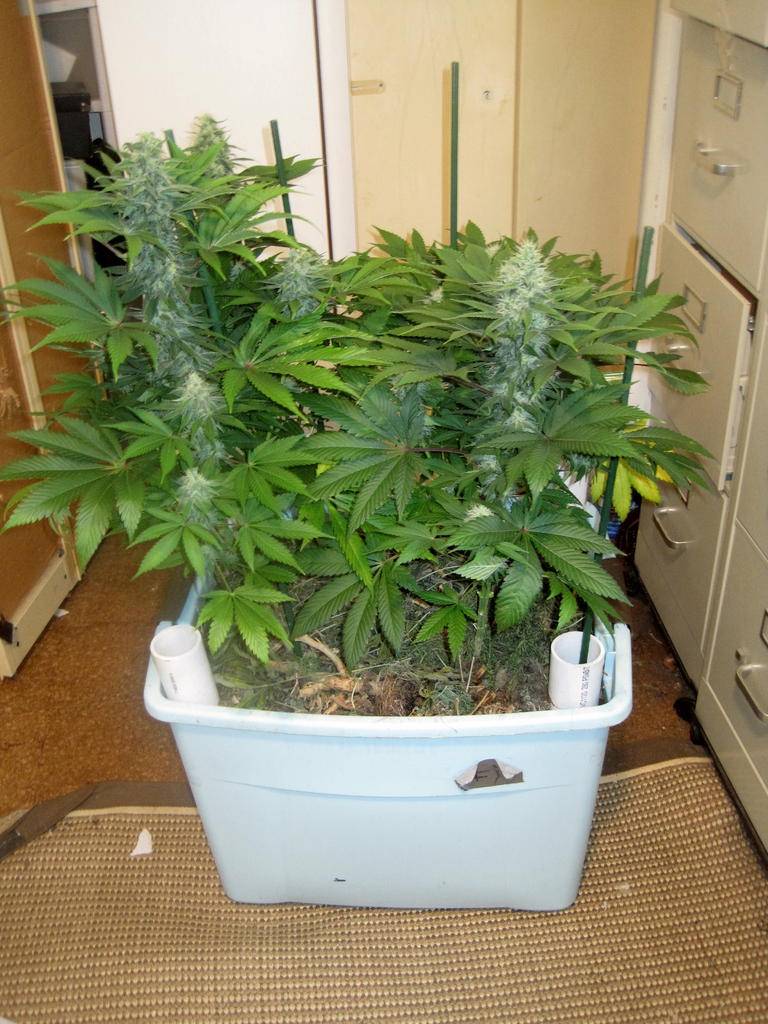
#4 bud shot:
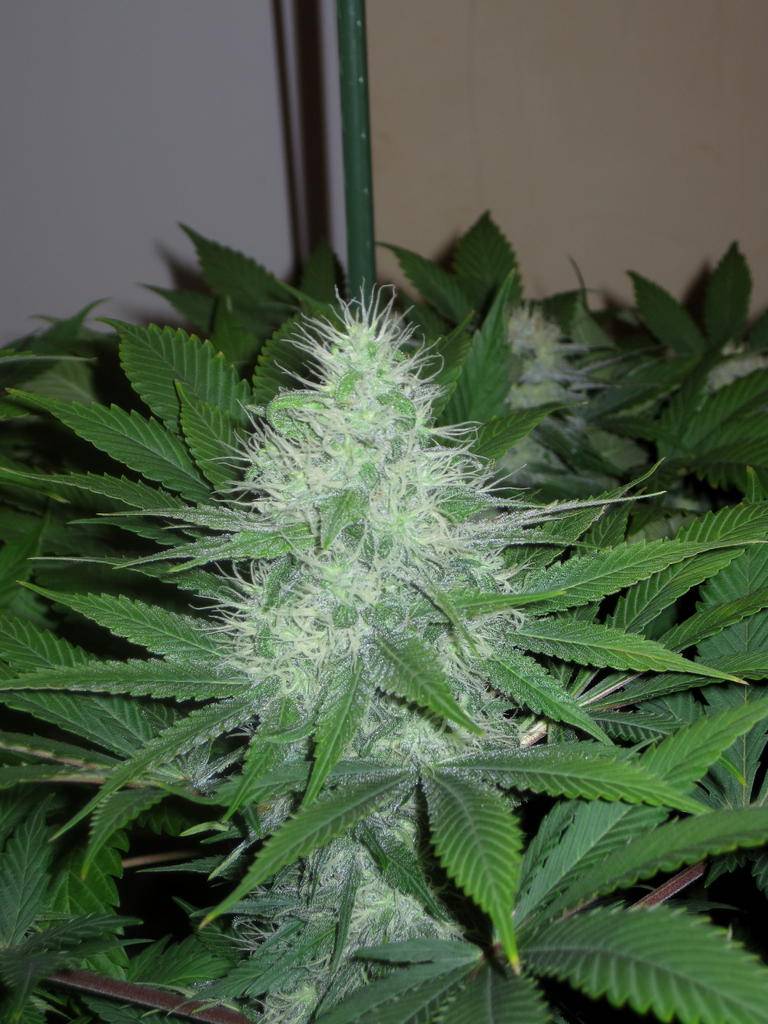
Cuts from all 4 plants (1-4 from L to R) with empty cups for the ones that didn't make it: You can see one of the #2 cuts and the #3 cut look pretty rough yet. There are signs of progress though. I think both will make it.
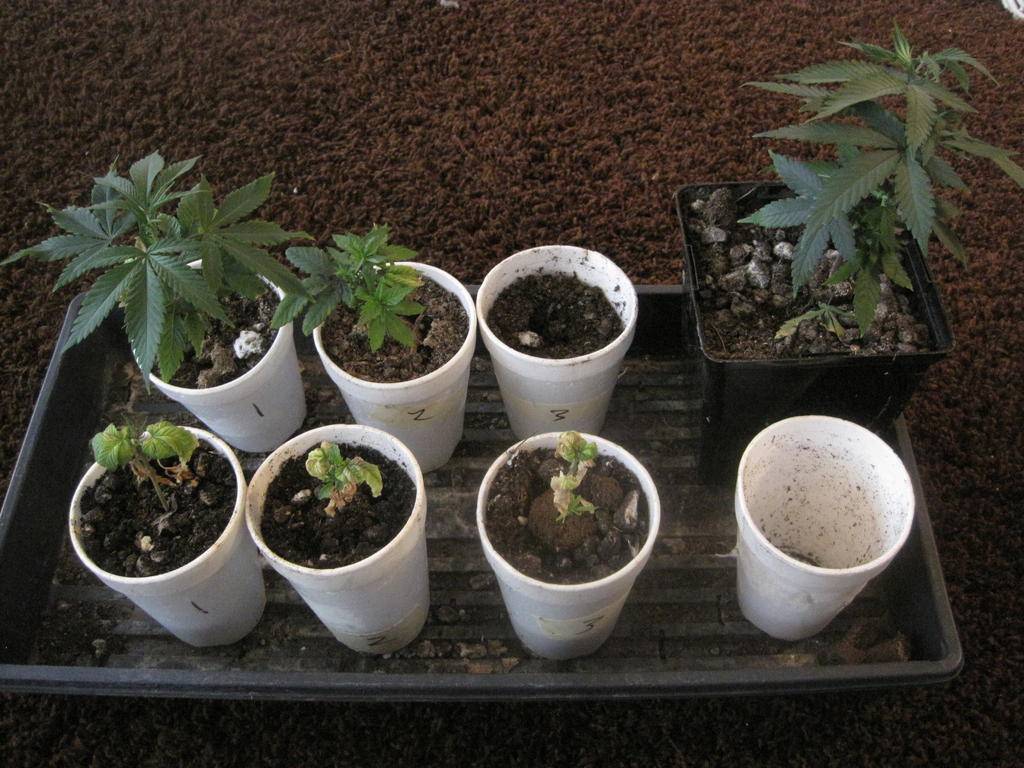
#2 cut: She is growing a new leaf
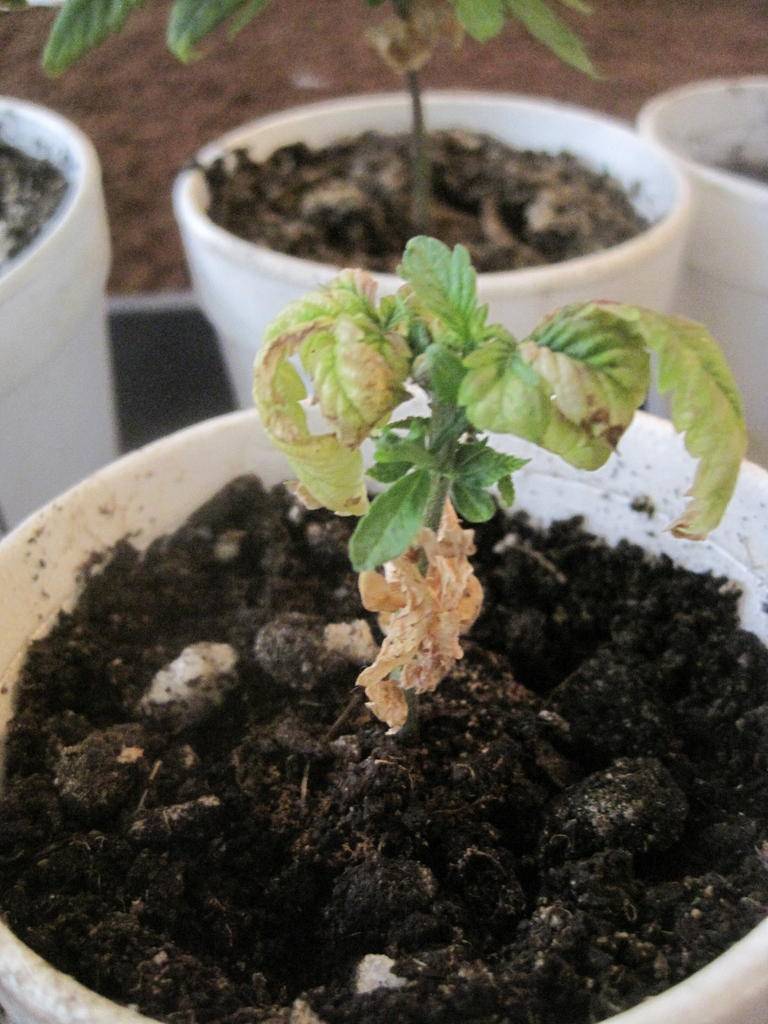
#3 cut: Also growing a new leaf.
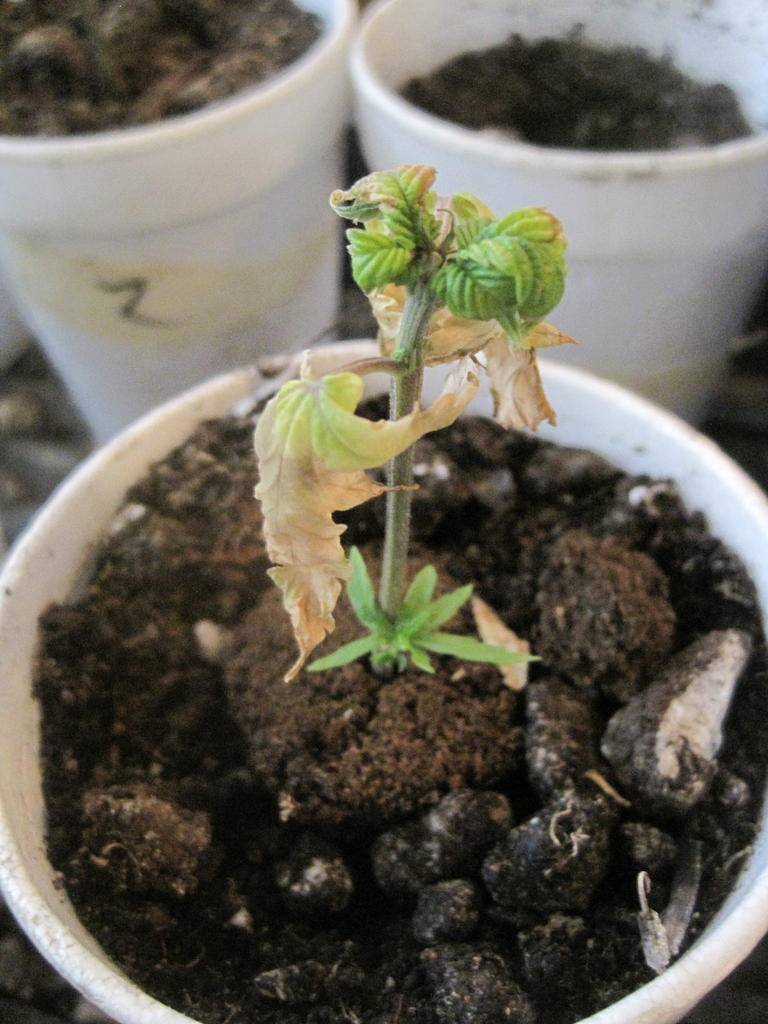
The SSH seeds are harvested from the cola I pollinated:
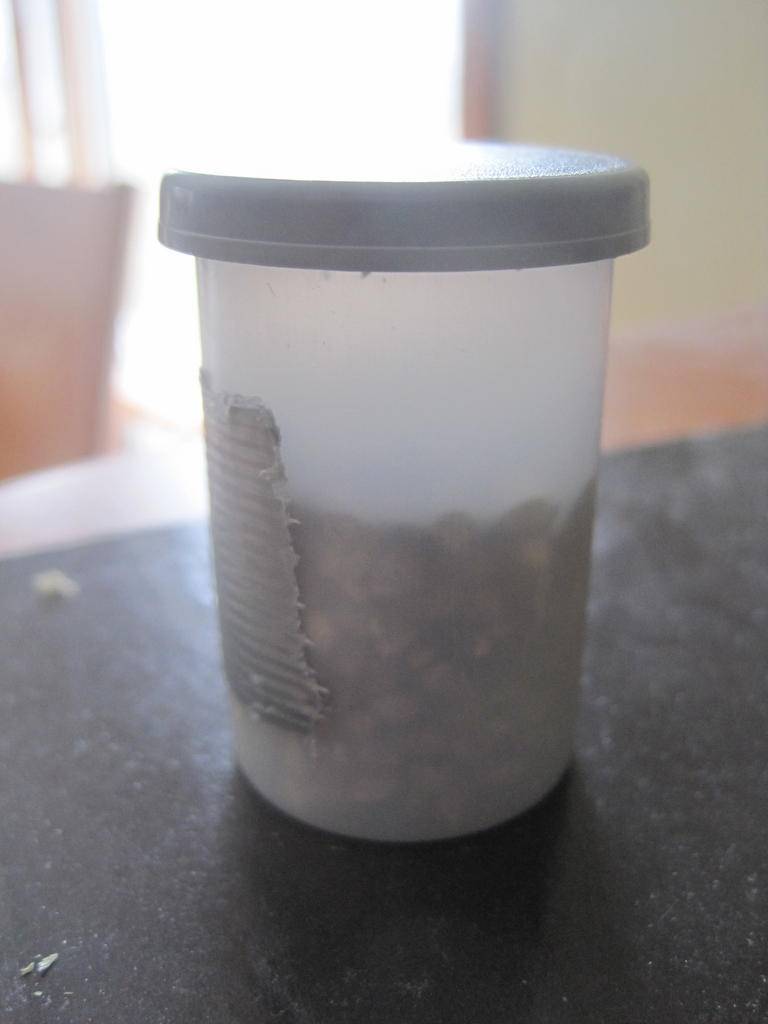
Some SSH BHO I made with the seeded bud: I didn't get a great return on this, but the material was not great because it was heavily seeded.
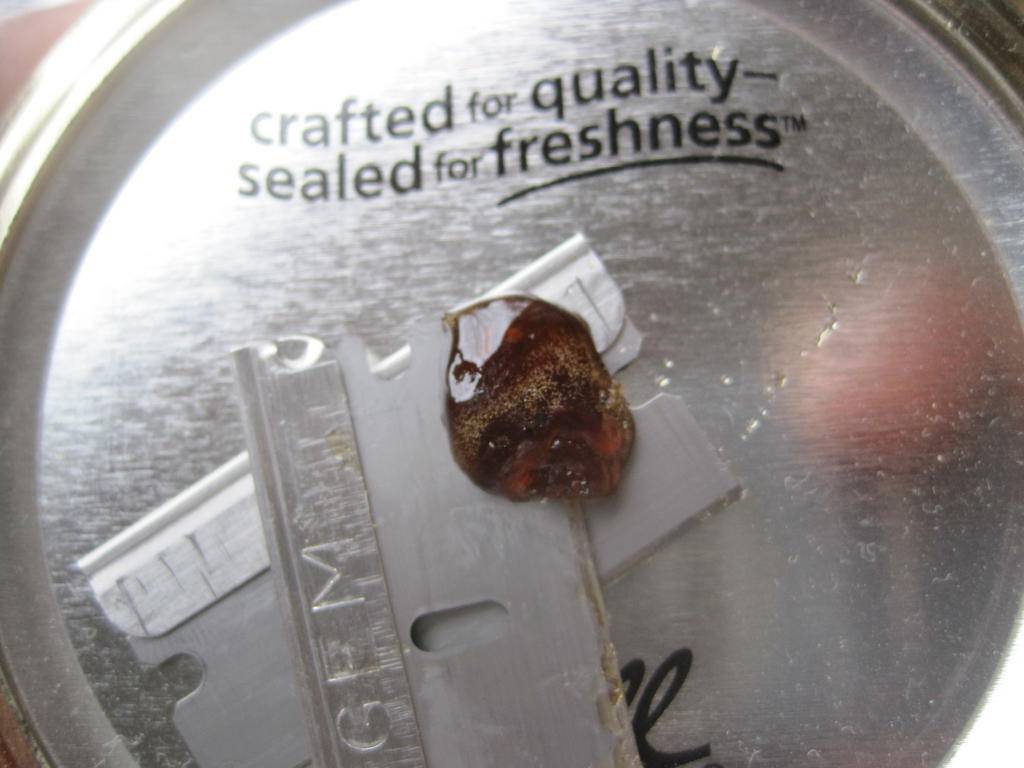
Lighter: If you are in the market for a torch lighter I'm happy to recommend this one by Vertigo, which is a subsidiary of the same company that makes the higher end Lotus lighters. It has a high capacity, but is still small enough to fit in your pocket - and for $30 it is very well constructed.
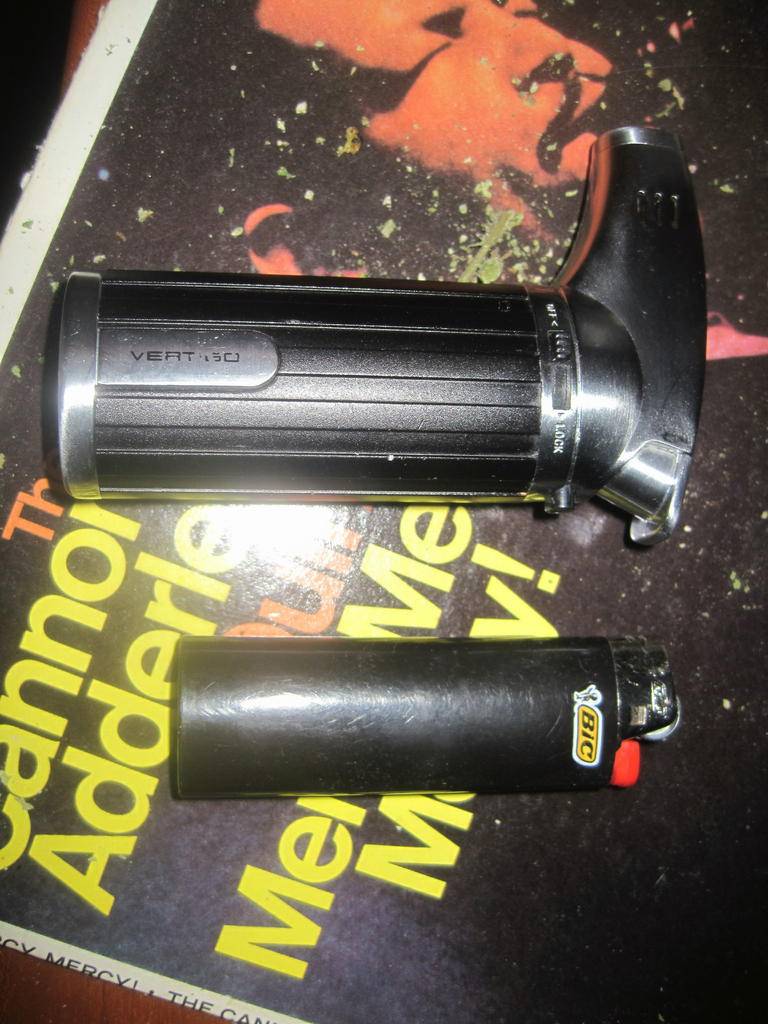
Overall the plants look pretty good. I am still having some problems with some of the cuttings. Right now I only have one plant, taken as a cutting from my #4 plant, which is capable of producing new cuts. For this reason, and because #4 is a fat, frosty, little fucker I think I'll run it again SOG style with 1.5-2' plants with an eye toward maximum yield. Right now I'm thinking about 6, 8 or 12 plants. Six would mean 2 rows deep and 2 across, 4 would mean 2 rows deep and 4 across, and 12 would mean 3 rows deep and 4 across.
Speaking of the cutting. I've been using Rapid Rooter plugs for rooting. The problem with these things is that they dry out over time. I've been trying to rehydrate them, but once they dry out they remain sort of crunchy. While I've rooted many a plant with crunchy plugs, they may have contributed to the problems I had rooting cuts from these plants. For this reason I'm going to try NAPA 8822 next.
I finally got around to harvesting some of the SSH bud that I intentionally pollinated. I guess I wasn't careful enough with the pollen because the entire crop was seeded. The branches I rubbed the male plant on were heavily seeded. From the #2 SSH plant I got more than half a film canister full of seeds. I made BHO with the trim from this seeded bud.
Pine
#1 and #2 front: #2 is a really nice looking plant, but I'm not going to be able to get cuts from her going until the end of the month, so I won't run her next (maybe after the next grow though).
#2 bud shot:
#3 and #4 front: #4 (right front) is the plant I plan to run next. #3 looks a bit pale in spots. I'm wondering if it isn't light bleaching because the paleness is uneven with the paler leafs being closer to the lamp. This is the tallest plant so it is closest to the light.
#4 bud shot:
Cuts from all 4 plants (1-4 from L to R) with empty cups for the ones that didn't make it: You can see one of the #2 cuts and the #3 cut look pretty rough yet. There are signs of progress though. I think both will make it.
#2 cut: She is growing a new leaf
#3 cut: Also growing a new leaf.
The SSH seeds are harvested from the cola I pollinated:
Some SSH BHO I made with the seeded bud: I didn't get a great return on this, but the material was not great because it was heavily seeded.
Lighter: If you are in the market for a torch lighter I'm happy to recommend this one by Vertigo, which is a subsidiary of the same company that makes the higher end Lotus lighters. It has a high capacity, but is still small enough to fit in your pocket - and for $30 it is very well constructed.
Pine, I just wanna say thank you for all your hard work and research you've done here.
I was hoping you could help me clarify some points on your system here. I'd like to try this technique as soon as possible.
1. Right now I've got Sunshine Mix #4 (mostly peat and perilite) that I'd like to re-use from a last grow (all organic nutrients were used). Can I add this in with some other ingredients and expect a decent run?
2. Your soil mix is part coco and part bat guano and sea kelp right? What are the ratios and is there any brands you suggest?
3. Do those pvc pipes help with Aeration? Would you suggest I install some of them.
4. When you water them do you PH your water to 6.0 or do you just leave it at 7.0 or whatever it comes out of the tap at?
5. After all of your hard work and research is there any extra tips or suggestions you could give me that would save me some head ache.
I'm really into re-using soil not so much for the time saving labour aspect, but more so for the environmental aspect. I'd rather grow my plants outside and not use any electricity at all and have an even lower carbon foot print, however the city that I live in I would surely get busted by thieves before anyone else lol.
I was hoping you could help me clarify some points on your system here. I'd like to try this technique as soon as possible.
1. Right now I've got Sunshine Mix #4 (mostly peat and perilite) that I'd like to re-use from a last grow (all organic nutrients were used). Can I add this in with some other ingredients and expect a decent run?
2. Your soil mix is part coco and part bat guano and sea kelp right? What are the ratios and is there any brands you suggest?
3. Do those pvc pipes help with Aeration? Would you suggest I install some of them.
4. When you water them do you PH your water to 6.0 or do you just leave it at 7.0 or whatever it comes out of the tap at?
5. After all of your hard work and research is there any extra tips or suggestions you could give me that would save me some head ache.
I'm really into re-using soil not so much for the time saving labour aspect, but more so for the environmental aspect. I'd rather grow my plants outside and not use any electricity at all and have an even lower carbon foot print, however the city that I live in I would surely get busted by thieves before anyone else lol.
1. Right now I've got Sunshine Mix #4 (mostly peat and perilite) that I'd like to re-use from a last grow (all organic nutrients were used). Can I add this in with some other ingredients and expect a decent run?
I don't see any reason why not. If you read through this thread you will see that when I first started this project the plants didn't do that well initially. I think you have to be prepared for this and to respond aggressively with ACTs, top dressed amendments, and foliar feeding. At one point early on I top dressed 2 cups of guano!
I've never re-used a peat based mix, but there are people around here with a lot of expertise in this. There might be some liming issues (like do you need to add more?).
2. Your soil mix is part coco and part bat guano and sea kelp right? What are the ratios and is there any brands you suggest?
It is LC's #1 mix with coco instead of peat and with Bongaloid's guano mix, both straight out of the first post in the organics for beginner's thread (https://www.icmag.com/ic/showthread.php?t=53792).
3. Do those pvc pipes help with Aeration? Would you suggest I install some of them.
I think of them as helping with gas exchange. I honestly don't know if they help, but they can't hurt. Obviously with no drainage you have to be somewhat careful with water.
4. When you water them do you PH your water to 6.0 or do you just leave it at 7.0 or whatever it comes out of the tap at?
Depending on the season my water is rain water (I assume it is neutral), store bought drinking water (pH 7.8, but low alkalinity), or RO. I don't pH any of it.
5. After all of your hard work and research is there any extra tips or suggestions you could give me that would save me some head ache.
Get some good mulch.
Good luck and let me know if I can be helpful.
Pine
I don't see any reason why not. If you read through this thread you will see that when I first started this project the plants didn't do that well initially. I think you have to be prepared for this and to respond aggressively with ACTs, top dressed amendments, and foliar feeding. At one point early on I top dressed 2 cups of guano!
I've never re-used a peat based mix, but there are people around here with a lot of expertise in this. There might be some liming issues (like do you need to add more?).
It is LC's #1 mix with coco instead of peat and with Bongaloid's guano mix, both straight out of the first post in the organics for beginner's thread (https://www.icmag.com/ic/showthread.php?t=53792).
I think of them as helping with gas exchange. I honestly don't know if they help, but they can't hurt. Obviously with no drainage you have to be somewhat careful with water.
Depending on the season my water is rain water (I assume it is neutral), store bought drinking water (pH 7.8, but low alkalinity), or RO. I don't pH any of it.
Get some good mulch.
Good luck and let me know if I can be helpful.
Pine
Awesome! Thanks for responding so quickly!
Just to clarify, what is some "good mulch"? Should I just buy it? Make it out of grass clippings in my yard?
Is the purpose of the good mulch to add nutrients for following grow or the present one? Or is it for water retention? Keeping pests away?
Just to clarify, what is some "good mulch"? Should I just buy it? Make it out of grass clippings in my yard?
Fall leafs and crop waste together make good mulch. Both are free.
Is the purpose of the good mulch to add nutrients for following grow or the present one? Or is it for water retention? Keeping pests away?
All of the above and to provide a habitat for soil biology of all sorts. If you add leaf material from outside you will likely end up with bugs, but the good kind. I've got all sorts of stuff in my tote now, including worms.
Pine
prowler
Member
EDIT: Wrong information... read more from below.
If you don't happen to have any leaf material at home currently gather some slightly rotten leaves from outside - or use living mulch. You can find a topic of living mulch in organic section. For dead mulch they say that the best is last years leaves - so that they contain lots of different leaf molds. And you can even do both.
Organics is fantastic. I never ever throw any green matter away. And when i pluck leaves i can throw them on the top of my pots.
I remember when i used to do RDWC with clay pebbles and picked every single leaf from the surface - now it's just the opposite. Couldn't be easier...
And again Pinecone you're serious power player. Respect.
If you think that your tap water has too high pH add some dolomite lime to your soil. Rain water is usually slightly acidic - if i've understand it correctly but mother nature does not seem to care. So kiss the pH meters and kits good bye and let the nature take care of it.
If you don't happen to have any leaf material at home currently gather some slightly rotten leaves from outside - or use living mulch. You can find a topic of living mulch in organic section. For dead mulch they say that the best is last years leaves - so that they contain lots of different leaf molds. And you can even do both.
Organics is fantastic. I never ever throw any green matter away. And when i pluck leaves i can throw them on the top of my pots.
I remember when i used to do RDWC with clay pebbles and picked every single leaf from the surface - now it's just the opposite. Couldn't be easier...
And again Pinecone you're serious power player. Respect.
If you think that your tap water has too high pH add some dolomite lime to your soil.
this is precisely wrong.
If you think that your tap water has too high pH add some dolomite lime to your soil. Rain water is usually slightly acidic - if i've understand it correctly but mother nature does not seem to care. So kiss the pH meters and kits good bye and let the nature take care of it.
I learned something from the below discussion yesterday.
Alkaline irrigation water and its effects on your growing media - https://www.icmag.com/ic/showthread.php?t=231106
My reading is that with high alkalinity, high pH water you may want to ditch the dolomite lime, even with highly acidic peat based mixes.
Pine
Got to appreciate the mentality of mad librettist also. He just punches you in the face and fades away
He would be happy to know that I sourced some white clover so that I can put in a living mulch (depending).
No more dolomite then.
Depending on your water and your mix you probably still want to use some. The issue is that it is not good if you have water that is high in calcium carbonates because DL is a calcium carbonate and your medium will filter these out over time. If I put together a new mix I would use some - along with gypsum and oyster shell (also a calcium carbonate).
Pine
I'm definitely having some issue with this grow. All the plants are showing some deficiencies, especially at the tops and closer to the light. Upper leafs are paling out and crisping from the edges in. I do not think these problems are related to my medium, anything in it or lack thereof, but if you disagree let me know.
Here is what I think is going on. The plants were very close to the light and the HPS runs hotter than the CMH I had in there. Additionally, someone turned the heat up to 70 and it was actually warmer in the room because it gets some heat from the ballast, light, and also from utilities located a floor below. The last thing is that it has been very dry here.
This post mcfly420 explains the rest of what I suspect is going on.
What am I going to do? I already lowered the plants to the floor and turned the thermostat off for that zone. I'm also thinking about opening a window, spraying the plants down with water when the lights go out, and turning off the 400cfm extractor fan for 12 hours.
Pine
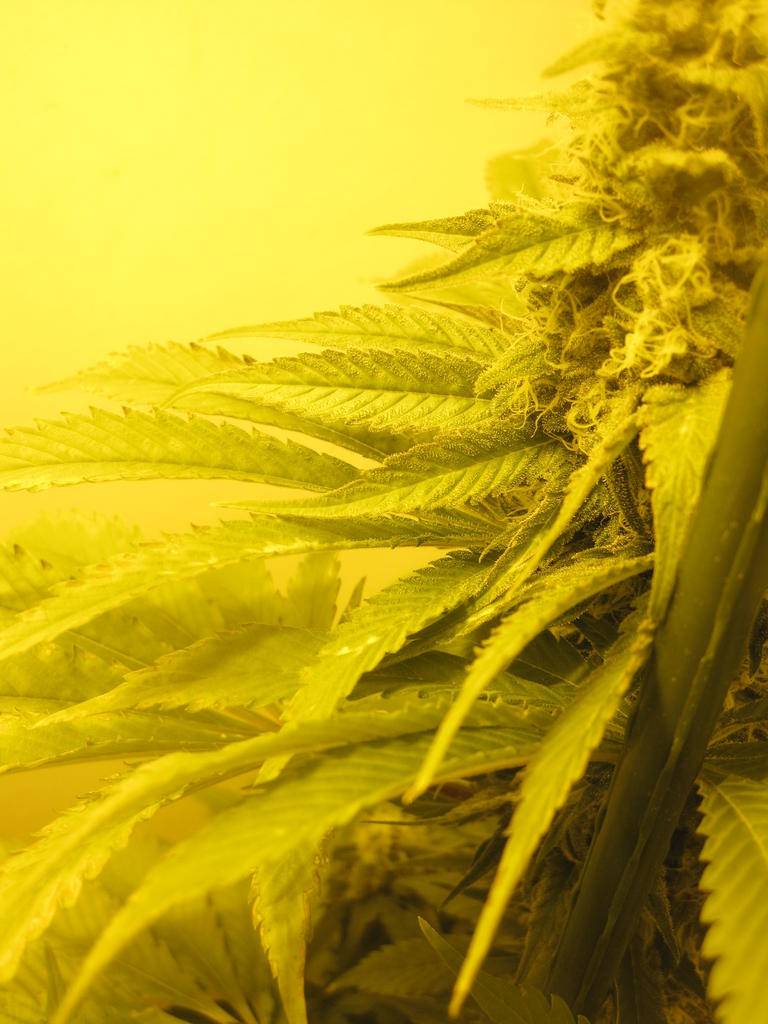
Here is what I think is going on. The plants were very close to the light and the HPS runs hotter than the CMH I had in there. Additionally, someone turned the heat up to 70 and it was actually warmer in the room because it gets some heat from the ballast, light, and also from utilities located a floor below. The last thing is that it has been very dry here.
This post mcfly420 explains the rest of what I suspect is going on.
VPD directly affects the rate of transpiration within the plant. Transpiration not only cools the plant, but the transpiration stream from root to leaf surface carries essential minerals up the plant to where they are needed for tissue development. Leaves exposed to the sun or overhead lamps would soon become dangerously hot if they were not cooled by water evaporating from the leaf surface—the process actually works in a similar way to sweat. This evaporated water needs to be replaced from the transpiration stream, which moves in the xylem vessels of the plant. If the water flow from roots to shoots in the xylem vessels is not fast enough, the plant will start to wilt and tissue damage will occur. The plant will shut its stomata in an attempt to retain turgor pressure and prevent wilting if too much water is being lost via transpiration. When the stomata shut to prevent water loss, photosynthesis cannot occur as CO2 can’t be taken in from the surrounding air, so plant growth and yield will be slowed if this occurs too often. Low humidity (high VPD) can cause large volumes of water from the transpiration stream to be lost to the air and force the plant to shut down its stomata to prevent desiccation.
What am I going to do? I already lowered the plants to the floor and turned the thermostat off for that zone. I'm also thinking about opening a window, spraying the plants down with water when the lights go out, and turning off the 400cfm extractor fan for 12 hours.
Pine
do you have some clip on fans or anything like that pointed at the hot spots?
do you have some clip on fans or anything like that pointed at the hot spots?
Nope - and blowing dry air around might make it worse. Here's the thing - it isn't even hot by the back of the hand standard and you have seen me with plants really close to the glass before without problems, so whats different this time? The combination of temperature and low humidity (30%). We have a lot of low humidity in the winter, but it normally isn't a problem. I betting that the additional heat created by the heat being turned up combined wit the HPS bulb were enough to make the low humidity an issue.
It seems kind of weird to be posting a link to a Maximum Yield article, but I'm going to do it anyway because it contains some useful information (actually this is where mcfly420's post game from). From the piece, the lower your temperature, the lower you can have your humidity without running into VPD induced problems.
Morgan, Lynn (2011). "Humidity, Vapor Pressure Deficit and the Transpiration Stream," Maximum Yield, January.
http://www.maximumyield.com/article...yearVar=2011&issueVar=January&featureVar=true
I might be completely wrong on this, but I see no other reason to be having these problems now. The were doing pretty good until an environmental factor changed (additional heat), the soil looks good and is full visible life, and I have feeding the system so there is enough there. All plants are not equally affected. On top of this, the damage on plants is localized with areas exposed to the light more affected. If I'm right they will get better quickly.
Pine


